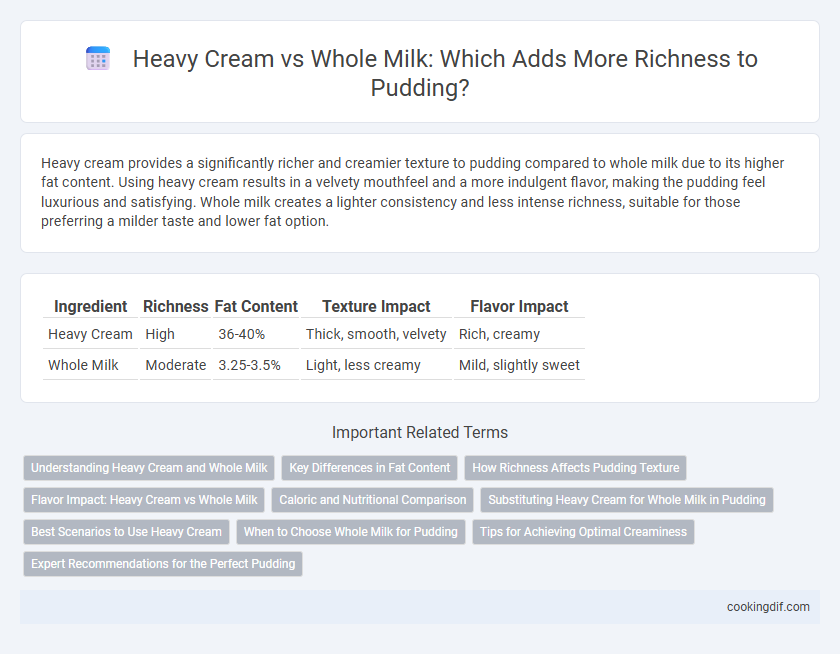Heavy cream provides a significantly richer and creamier texture to pudding compared to whole milk due to its higher fat content. Using heavy cream results in a velvety mouthfeel and a more indulgent flavor, making the pudding feel luxurious and satisfying. Whole milk creates a lighter consistency and less intense richness, suitable for those preferring a milder taste and lower fat option.
Table of Comparison
| Ingredient | Richness | Fat Content | Texture Impact | Flavor Impact |
|---|---|---|---|---|
| Heavy Cream | High | 36-40% | Thick, smooth, velvety | Rich, creamy |
| Whole Milk | Moderate | 3.25-3.5% | Light, less creamy | Mild, slightly sweet |
Understanding Heavy Cream and Whole Milk
Heavy cream contains around 36-40% fat, providing a rich, velvety texture and intense creaminess essential for decadent pudding. Whole milk has approximately 3.5-4% fat, resulting in a lighter, less creamy consistency that may yield a thinner pudding. Understanding the fat content and texture differences helps in choosing heavy cream for indulgent richness or whole milk for a subtler, classic pudding experience.
Key Differences in Fat Content
Heavy cream contains about 36-40% fat, making it significantly richer than whole milk, which has roughly 3.25% fat content. This high fat concentration in heavy cream contributes to a thicker, creamier texture and a more luxurious mouthfeel in pudding recipes. Using whole milk results in a lighter consistency with less richness, ideal for those seeking a lighter dessert option.
How Richness Affects Pudding Texture
Heavy cream significantly enhances pudding richness by increasing fat content, resulting in a velvety, smooth texture with a luxurious mouthfeel. Whole milk, with lower fat levels, produces a lighter texture and less creamy consistency, making the pudding more delicate but less dense. Richness directly impacts pudding's firmness and silkiness, where higher fat solidifies a richer, more indulgent texture that holds shape better.
Flavor Impact: Heavy Cream vs Whole Milk
Heavy cream provides a richer, more luxurious texture to pudding due to its high fat content, which intensifies flavor and creates a creamy mouthfeel. Whole milk offers a lighter, smoother consistency with a subtle sweetness, allowing other ingredients to shine without overpowering the dish. The choice between heavy cream and whole milk directly influences the pudding's depth of flavor and overall indulgence level.
Caloric and Nutritional Comparison
Heavy cream contains approximately 820 calories and 88 grams of fat per cup, offering a richer, creamier texture for pudding compared to whole milk's 150 calories and 8 grams of fat per cup. Nutritionally, whole milk provides more protein and essential vitamins like calcium and vitamin D, while heavy cream is significantly higher in saturated fat and calories. Choosing heavy cream enhances pudding's richness and mouthfeel, whereas whole milk contributes to a lighter option with fewer calories and higher nutrient density.
Substituting Heavy Cream for Whole Milk in Pudding
Substituting heavy cream for whole milk in pudding significantly enhances its richness and creamy texture due to the higher fat content of heavy cream, which is typically around 36-40% compared to whole milk's 3.5-4%. This substitution increases the pudding's velvety mouthfeel and depth of flavor, making it more indulgent and luxurious. However, heavy cream can also make the pudding denser and more calorie-dense, so quantity adjustments may be necessary to maintain the desired consistency.
Best Scenarios to Use Heavy Cream
Heavy cream enhances pudding with a rich, velvety texture and a luxurious mouthfeel that whole milk cannot replicate, making it ideal for decadent desserts like chocolate or caramel pudding. Its higher fat content provides stability and creaminess, which works best in recipes requiring thick consistency and indulgent flavor profiles. Use heavy cream when a smooth, luscious pudding experience is desired, especially for special occasions or gourmet presentations.
When to Choose Whole Milk for Pudding
Whole milk is ideal for pudding recipes that require a lighter texture and a less intense richness, making it suitable for delicate flavors like vanilla or fruit-based puddings. It provides a smooth mouthfeel without overwhelming the dish, balancing creaminess and moisture effectively. When a subtle dairy presence is preferred without the heaviness of fat, whole milk enhances the pudding's consistency while keeping it light and refreshing.
Tips for Achieving Optimal Creaminess
Using heavy cream instead of whole milk significantly enhances pudding's richness by adding higher fat content, which creates a smoother, creamier texture. For optimal creaminess, gently heat the dairy and avoid boiling to prevent curdling and preserve the pudding's velvety consistency. Incorporating a small amount of cornstarch or egg yolk further stabilizes the mixture, resulting in a perfectly thickened, luscious dessert.
Expert Recommendations for the Perfect Pudding
Expert chefs recommend using heavy cream in pudding recipes for a richer, creamier texture due to its higher fat content, typically around 36-40%. Whole milk, with about 3.5% fat, produces a lighter consistency but lacks the luxurious mouthfeel that heavy cream imparts. For the perfect pudding, combining heavy cream with whole milk balances decadence and smoothness, achieving optimal richness without overwhelming heaviness.
Heavy cream vs whole milk for richness Infographic

 cookingdif.com
cookingdif.com